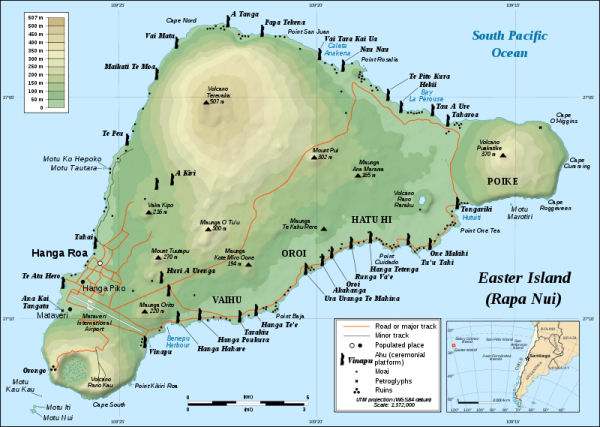Airport closed by Islanders
In August this year (2009) Easter Islanders, who are mostly of Polynesian origin, 'closed' their island for 24 hours, blocking the one airport. Their purpose was to demand limits on immigration from Chili and on the length of time tourists might come and stay.
The were demonstrating because of the impact of tourism and population growth on the island. The French Press described it as a fear that their 'island paradise' might be lost, but we should remember that the Rapanuans, as the inhabitants of Easter Island probably prefer to be known, clawed back from the brink of extinction after overpopulation, nearly reduced their island to a desert in the 18th century, forcing some of their ancestors to survive by cannibalism. If this island has returned to paradise status, it has been dearly-won.
It is ironic that the island that the world knows as the most famous case of overpopulation should even have to ask for control over their population numbers, but inspiring that the Chilean government has recognised this right in a country not known for its attention to human rights.
According to

Illustration: Interactive Wikipedia map of Easter Island and its sights
Dangerously High European Immigration
The population has increased at a dangerously rapid pace, mainly due to the influx of people of European descent via the Chilean mainland. At the 2002 census there were 3,791 inhabitants, up from 1,936 inhabitants in 1982. By 2009 there were about 5000 inhabitants. Rapanui is 163.6 km2, with little fresh water.
The island is also losing its native Polynesian identity to European Chilean sea-changers. The native Polynesians (known as Rapanuians) have dwindled from around 70% in 1982, to 60% in the 2002 census. Chileans of European descent formed 39% of the population, with 1% Native American from mainland Chile.) (Source: Easter Island Article ID: 53418

Each year 50,000 tourists come to visit the beaches and volcanic landscapes which are world famous for their giant Moai statues of stone. Rapanui is 3,500km from the Chilean coast, once the most isolated island in the Pacific, and the last to be settled by Polynesians. Some theories have it that the islanders' ancestors chopped down the last trees in order to keep on making those statues. The statues stare out to sea like an island SETI program, as if signalling that the island was inhabited, hoping that this once most isolated island in the Pacific might to be found by other friendly Polynesians in the once endlessly large universe of the Pacific Ocean.
In fact the island was found by unfriendly Europeans and many of the islanders who had survived cannibalism and starvation, were taken away as slaves in the 18th century.
Today the stone statues are again attracting the wrong sort of crowd.
Easter Islanders get power to limit immigration to their island
In October this year, after public consultation, the people of Easter Island (Rapanui) approved a reform of the Chilean constitution which will give authorities on Easter Island more control over migration movements. This was an initiative of the Chilean Government, designed in response to Islander concerns about the impact on their ecosystem and culture of growth in tourism and immigration.
96% vote to restrict immigration and tourism
Some 1,300 - or more than 96% of voters welcomed the reform, according to Chilean media sources,
The Vice Minister of the Interior, Patricio Rosende, explained that the vote will "help to regulate the growth of the population of the island. It is a very fragile place which won't support an indeterminate number of permanent inhabitants."
In September the government had launched a system of immigration cards to control the reason, length of stay and place of stay for visitors, as a first step to control immigration traffic. The Supreme Court in early October had ruled that this idea was 'illegal and arbitrary in the name of freedome to come and go in the country.'
The vote in October would launch a process to revise the article in the Constitution which already recognises that Easter Island has a special status.
Source of above:"L'île de Pâques vote pour contrôler ses visiteurs," Agence France-Presse, Santiago, Publié le 27 octobre 2009 à 07h52 | Mis à jour le 27 octobre 2009 à 07h55 and France2 archived television video at http://info.francetelevisions.fr/video-info/index-fr.php?id-video=MAM_1500000000004645_200908181520_F2 Accessed on 27 December 2009. Easter Island Article ID: 53418
The Future Eating Syndrome
Nowhere is the ability of a system to limit growth more important than on isolated islands. The Pacific Islands were the last in the world to be severely disorganised by colonisation and the ideology of "Progress" so dear to the growth lobby. The destruction of their original societies was documented by many sources, including religious, commercial and anthropological. But the fact is, Easter Island's grisly history turns out to be the exception to the Pacific Islander rule - at least for those many island societies that survived well. Generally, Pacific Island societies have been the greatest survivors ever known, with some lasting more than 40,000 years. Even Hawaii had lasted for about 3000 years before the arrival of Europeans. Japan is another example of a Pacific island that succeeded for a very long time without overshooting its resources. No modern European society can claim anything like this success.
The Easter Island story is of the late colonisation by a single party of Polynesians of one of the most isolated islands in the Pacific.
It was so isolated that it is thought likely that no further traditional Polynesian colonisers ever arrived. Despite these inauspicious circumstances, this one party of Polynesians seeded a complex civilisation in 390 or 400AD which reached numbers between 7000 and 10,000, profiting from the abundant sea-life and productive vegetation. But the downfall of the Easter Islanders apparently lay in their very success, for they reputedly ate themselves out of house and home, finally dwindling to a handful of incestuous cannibals, surrounded by those mute giant statues which had been produced by their dead civilisation. By 1700 AD population had dropped from an estimated 10,000 to around one or two thousand. It is thought that no visitors landed until the first European voyagers in 1722 who described the straggling survivors of the former nation.
This form of death to a society by over consumption has been held up as the likely or even as the inescapable fate of modern man and consumer society by eco-gurus such as Jarad Diamond (Collapse) and Tim Flannery. Tim Flannery called it "Future Eating" in his famous 1994 book, The Future Eaters (Reed Books). In a series of international petroleum depletion discussion e-lists led initially by Jay Hansen of www.dieoff.org, Easter Island has been held up to illustrate the proposition that humans will always overshoot their environmental carrying capacity.
That people of 'progressive' cultures have so easily identified Pacific Island societies as hopelessly unsustainable lies in the severe dysfunction of most Pacific Islander cultures since the majority were exposed to 'Progress' through mostly British colonisation from the 1850s. The spectacular fate of the Easter Island, which was thought to have occurred before any colonisation, simply confirms in most "Progressive" peoples' minds that the poor Pacific islanders must always have existed in hopelessly dysfunctional societies, doomed to bloom and die like so many tropical blossoms, due to some innate lack of the progress gene.
But all Pacific islands did not end up like Easter Island. Most did not. So the whole proposition that Pacific Islanders are chronicly in need of direction from outsiders is flawed. And there must be an antidote to the Easter Island future-eating syndrome.
Australia is to be counted among the once-isolated islands of the Pacific and Australian Aborigines once used the same sustainable land-tenure and inheritance system as all other successful islanders. The Australian and New Guinean Lapita people were present in societies at least 40,000 years ago.
'Modern' Australia is a product of British colonial history and a victim of the British capitalist land-tenure and inheritance system. For all that it is bigger and more resourced than its smaller neighbours and for all that the white population far outnumbers the original black population, Australia is dogged by the same exploitation, overpopulation, and ruin as the other British-colonised islands. Because Australia is bigger than the other Pacific islands, its ruin is taking a little longer than some islands' and most of us cannot see that what is happening in our suburb is happening all over Australia's thin strip of fertile coast. Rest assured, however, that if we keep going as we are, we won't last nearly as long as Easter Island did before it crashed. And, what is happening to Australia is also happening to North America, Canada and Britain.
Wouldn't it be great if the people of Rapanui, having learned from the pain of being unfairly held up as an example to the world, were able to stop overpopulation destroying them a second time.
Let's wish them the best of luck and follow their example!
JUST PUBLISHED UPDATE:
UPDATE DEC 2012: If you would like to know more, Sheila Newman has applied a completely new test of the collapse model of Easter Island, which will stun those who thought they knew all about it. Read about this in chapter four of Demography, Territory & Law: The Rules of Animal and Human Populations (see link). Forensic biologist, Hans Brunner writes of it: "This book takes us to a completely new paradigm in multiple species population science. It shows how little we understand, and how much we need to know, of the sexual reactions when closed colonies with an orderly reproduction system are destroyed, be it people or animals." Two chapters are on multi-species demography, the rest apply the theory to non-industrial societies, including Rapanui

 Click for French tv coverage
Click for French tv coverage
Comments
quark
Tue, 2009-12-29 11:26
Permalink
Easter Island
Tigerquoll
Wed, 2009-12-30 13:04
Permalink
Migrants just exercising their pathogenic rights
Vivienne (not verified)
Wed, 2009-12-30 13:43
Permalink
Protect us from madmen and economists!
Vivienne (not verified)
Sat, 2010-01-02 09:25
Permalink
"Populate AND Perish"!
Tigerquoll
Sat, 2010-01-02 23:08
Permalink
Rudd is Australia's most wanted invading foreigner.
Vivienne highlights the Australian government's post-war immigration policy of the 50's encouraged by Arthur Caldwell, but that was a small start and long ago. A closer analysis between the alignment of successive governments and immigration statistics would reveal a more recent policy trend that makes Caldwell's immigration enthusiasm pale in comparison to today's 383,000 per annum.
The 'populate or perish' myth was spun and believed but never legitimated - and quite comparable to Bush/Howard/Blair Weapons of Mass Deception spin [BHB WMD]. Like WMD, the preceding 'populate or perish' myth remains an historian's gem of a book waiting to have the deception exposed. It just opened the immigration flood gates on a lie that has been ignored and abandoned.
It's bleeding obvious that Australian standards and way of life are being eroded due to a few powerful politicians that in some twisted noble way think it's good for us to be globally accepting. No need to elaborate on the 'high home-ownership', 'close-knit families' etc, but thanks for the confirmation.
Immigration only boosts short term economic data. The key problem is that Australia Treasury departments are dominated and controlled by economists and politicians know no better. These days Treasury is blindly accepted as the unquestioned head economic Druid. Politicians are intimidated by economic science to thinking that they have no social/economic savvy with which to challenge Treasury's mandate. The power and influence is prevalent at both national and state level.
Rudd’s rationale and drive are undisclosed. One man is taking Australian values and lifestyle down a degraded path. The test ought to be that the current generation leaves a better Australia for the next. Rudd makes no apology that his personal concept “of a bigger Australia” is a different goal. I argue it is a goal foreign to Australia and that Rudd needs to be treated as an illegitimate invading foreigner.
When Rudd is long gone his destruction will prevail permanently, especially at 383,000 net immigration per year!
Tiger Quoll
Snowy River 3885
Australia
James Sinnamon
Sun, 2010-01-03 01:36
Permalink
Rudd cannot be motivated by altruism, twisted or otherwise.
Anonymous (not verified)
Thu, 2010-02-04 00:00
Permalink
Rudd's immigration
Add comment